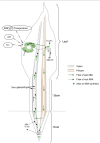ABA-Mediated Stomatal Response in Regulating Water Use during the Development of Terminal Drought in Wheat
- PMID: 28769957
- PMCID: PMC5513975
- DOI: 10.3389/fpls.2017.01251
ABA-Mediated Stomatal Response in Regulating Water Use during the Development of Terminal Drought in Wheat
Abstract
End-of-season drought or "terminal drought," which occurs after flowering, is considered the most significant abiotic stress affecting crop yields. Wheat crop production in Mediterranean-type environments is often exposed to terminal drought due to decreasing rainfall and rapid increases in temperature and evapotranspiration during spring when wheat crops enter the reproductive stage. Under such conditions, every millimeter of extra soil water extracted by the roots benefits grain filling and yield and improves water use efficiency (WUE). When terminal drought develops, soil dries from the top, exposing the top part of the root system to dry soil while the bottom part is in contact with available soil water. Plant roots sense the drying soil and produce signals, which on transmission to shoots trigger stomatal closure to regulate crop water use through transpiration. However, transpiration is linked to crop growth and productivity and limiting transpiration may reduce potential yield. While an early and high degree of stomatal closure affects photosynthesis and hence biomass production, a late and low degree of stomatal closure exhausts available soil water rapidly which results in yield losses through a reduction in post-anthesis water use. The plant hormone abscisic acid (ABA) is considered the major chemical signal involved in stomatal regulation. Wheat genotypes differ in their ability to produce ABA under drought and also in their stomatal sensitivity to ABA. In this viewpoint article we discuss the possibilities of exploiting genotypic differences in ABA response to soil drying in regulating the use of water under terminal drought. Root density distribution in the upper drying layers of the soil profile is identified as a candidate trait that can affect ABA accumulation and subsequent stomatal closure. We also examine whether leaf ABA can be designated as a surrogate characteristic for improved WUE in wheat to sustain grain yield under terminal drought. Ease of collecting leaf samples to quantify ABA compared to extracting xylem sap will facilitate rapid screening of a large number of germplasm for drought tolerance.
Keywords: abscisic acid; grain yield; root hydraulic conductivity; stomatal conductance; water use efficiency.
Figures
Similar articles
-
Root biomass in the upper layer of the soil profile is related to the stomatal response of wheat as the soil dries.Funct Plant Biol. 2015 Feb;43(1):62-74. doi: 10.1071/FP15216. Funct Plant Biol. 2015. PMID: 32480442
-
[Effect of nitrogen nutrition on endogenous hormone content of maize under soil drought conditions].Ying Yong Sheng Tai Xue Bao. 2003 Sep;14(9):1503-6. Ying Yong Sheng Tai Xue Bao. 2003. PMID: 14733008 Chinese.
-
Canopy stomatal conductance and xylem sap abscisic acid (ABA) in mature Scots pine during a gradually imposed drought.Tree Physiol. 2002 Aug;22(12):877-83. doi: 10.1093/treephys/22.12.877. Tree Physiol. 2002. PMID: 12184977
-
Signaling Transduction of ABA, ROS, and Ca2+ in Plant Stomatal Closure in Response to Drought.Int J Mol Sci. 2022 Nov 26;23(23):14824. doi: 10.3390/ijms232314824. Int J Mol Sci. 2022. PMID: 36499153 Free PMC article. Review.
-
Mechanism of Stomatal Closure in Plants Exposed to Drought and Cold Stress.Adv Exp Med Biol. 2018;1081:215-232. doi: 10.1007/978-981-13-1244-1_12. Adv Exp Med Biol. 2018. PMID: 30288712 Review.
Cited by
-
Drought and Salinity Stress Responses and Microbe-Induced Tolerance in Plants.Front Plant Sci. 2020 Nov 13;11:591911. doi: 10.3389/fpls.2020.591911. eCollection 2020. Front Plant Sci. 2020. PMID: 33281852 Free PMC article. Review.
-
Abscisic acid improves drought resilience, growth, physio-biochemical and quality attributes in wheat (Triticum aestivum L.) at critical growth stages.Sci Rep. 2024 Sep 2;14(1):20411. doi: 10.1038/s41598-024-71404-4. Sci Rep. 2024. PMID: 39223242 Free PMC article.
-
Molecular Mechanism for the Regulation of ABA Homeostasis During Plant Development and Stress Responses.Int J Mol Sci. 2018 Nov 19;19(11):3643. doi: 10.3390/ijms19113643. Int J Mol Sci. 2018. PMID: 30463231 Free PMC article. Review.
-
Root Plasticity in the Pursuit of Water.Plants (Basel). 2019 Jul 22;8(7):236. doi: 10.3390/plants8070236. Plants (Basel). 2019. PMID: 31336579 Free PMC article. Review.
-
Determining the Genetic Architecture of Reproductive Stage Drought Tolerance in Wheat Using a Correlated Trait and Correlated Marker Effect Model.G3 (Bethesda). 2019 Feb 7;9(2):473-489. doi: 10.1534/g3.118.200835. G3 (Bethesda). 2019. PMID: 30541928 Free PMC article.
References
-
- Ali M., Jensen C. R., Mogensen V. O. (1998). Early signals in field grown wheat in response to shallow soil drying. Funct. Plant Biol. 25 871–882. 10.1071/pp98061 - DOI
-
- Asseng S., Jamieson P. D., Kimball B., Pinter P., Sayre K., Bowden J. W., et al. (2004). Simulated wheat growth affected by rising temperature, increased water deficit and elevated atmospheric CO2. Field Crops Res. 85 85–102. 10.1016/s0378-4290(03)00154-0 - DOI
-
- Atkinson C. J., Davies W. J., Mansfield T. A. (1989). Changes in stomatal conductance in intact ageing wheat leaves in response to abscisic acid. J. Exp. Bot. 40 1021–1028. 10.1093/jxb/40.9.1021 - DOI
-
- Atwell B. J., Kriedemann P. E., Turnbull C. G. N. (eds) (1999). “Water: a limiting factor,” in Plants in Action: Adaptation in Nature, Performance in Cultivation (Melbourne: Macmillian Education Australia Pty Ltd).
Publication types
LinkOut - more resources
Full Text Sources
Other Literature Sources
Miscellaneous


